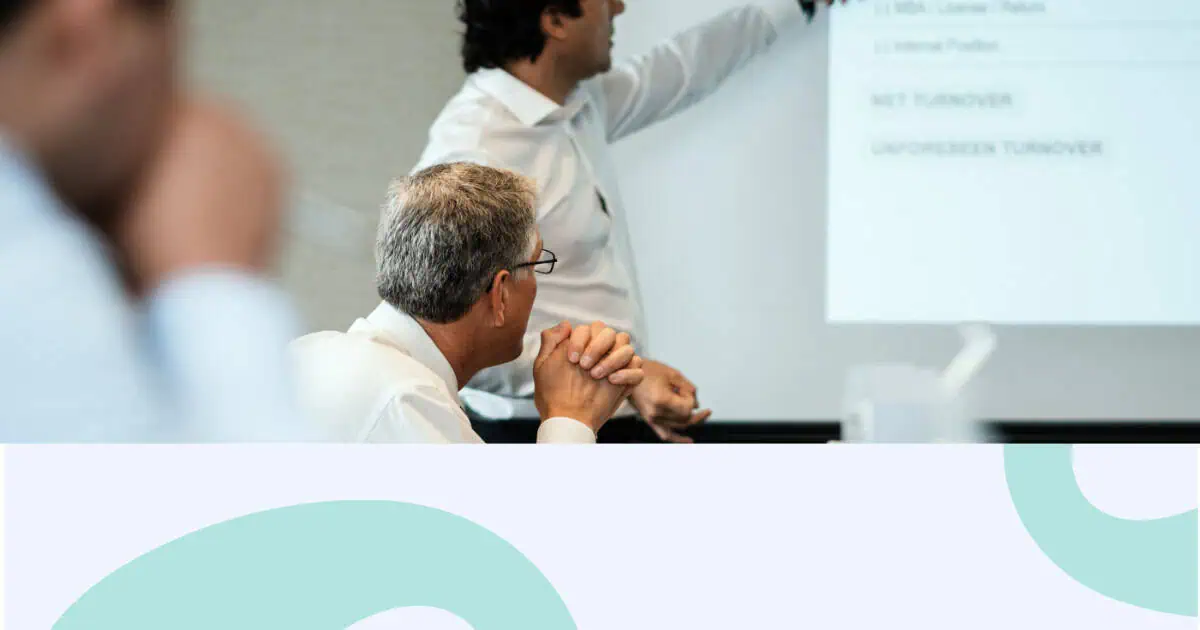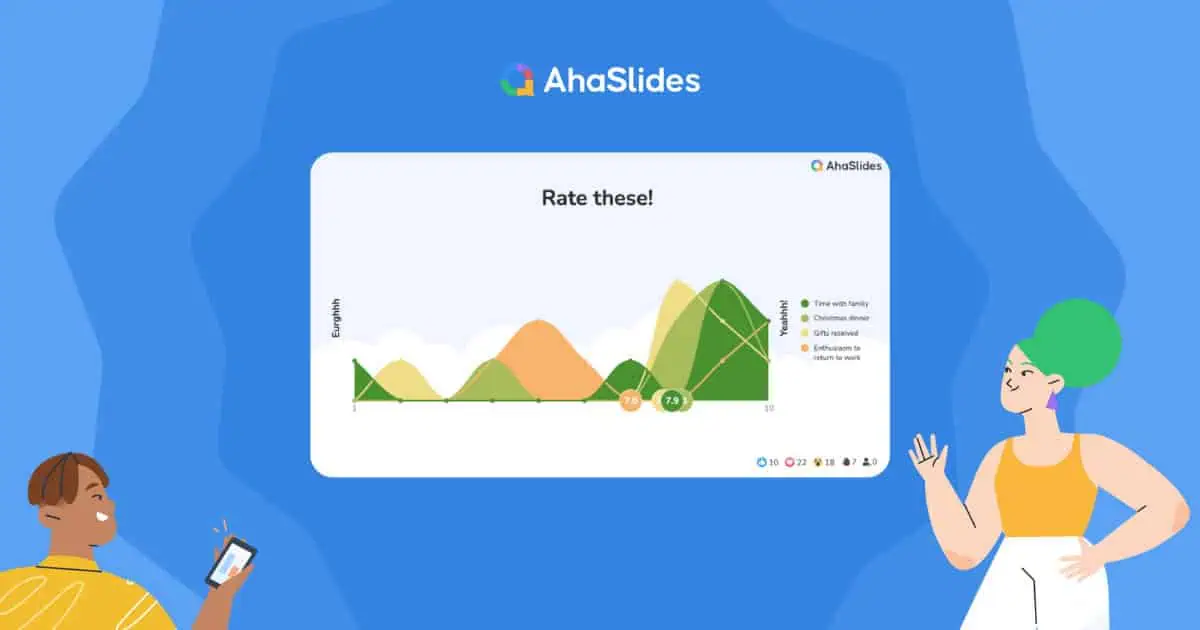בכלכלת תשומת הלב של היום, המאומנת על ידי טיקטוק, יש לכם בערך 8 שניות ללכוד את תשומת ליבו של מישהו - פחות זמן מדג זהב. אם זה נשמע מרתיע עבור מצגת של 5 דקות, הנה החדשות הטובות: מצגות קצרות הן הנשק הסודי שלכם.
בזמן שאחרים מתבוננים בין מצגות של 60 שקופיות וצופים בעיניים מתעמעמות, אתם תעבירו מסר ממוקד שנדבק. בין אם אתם מציגים מצגות למשקיעים, מאמנים צוות מרוחק, מציגים ממצאי מחקר או מתראיינים לתפקיד החלומות שלכם, שליטה בפורמט של 5 דקות היא לא רק נוחה - היא מגדירה את הקריירה שלכם.
מדריך זה מתבסס על מדע המצגות, תובנות של מאמנים מקצועיים המעבירים מאות מפגשים מדי שנה, וטכניקות מוכחות של דוברי TED שיעזרו לכם ליצור מצגות שמעניינות, משכנעות ומשאירות רושם מתמשך.
תוכן העניינים
למה מצגות של 5 דקות דורשות גישה שונה
מחקר מחקר של חוקר המוח ג'ון מדינה מראה כי תשומת הלב של הקהל יורדת משמעותית כל 10 דקות במהלך מצגות מסורתיות. במסגרות וירטואליות, חלון זמן זה מצטמצם ל-4 דקות בלבד. המצגת שלכם בת 5 דקות מתאימה באופן מושלם לנקודת המבט המתאימה הזו - אבל רק אם תעצבו אותה נכון.
ההימור גבוה יותר עם מצגות קצרות. כל מילה חשובה. כל שקופית חשובה. אין זמן למילוי, אין מקום לנקודות עקיפה, ואפס סובלנות לפאשלות טכניות. מחקרים בתעשייה מראים ש-67% מהמקצוענים מעדיפים כיום מצגות תמציתיות וממוקדות על פני מצגות ארוכות - אך רוב המציגים עדיין ניגשים להרצאות קצרות כגרסאות מרוכזות של הרצאות ארוכות, מה שרק לעתים רחוקות עובד.
איך להכין מצגת של 5 דקות
שלב 1: בחרו את הנושא שלכם בדיוק כירורגי

הטעות הגדולה ביותר של מרצים? ניסיון לכסות יותר מדי נושאים. המצגת שלך בת 5 דקות צריכה להתייחס... רעיון מרכזי אחד—לא שלושה, אפילו לא שניים. תחשבו על זה כלייזר, לא כזרקור.
הנושא שלך חייב לעבור את המבחן בן ארבעת השלבים הבאים:
- נקודת מיקוד יחידה: האם תוכל להסביר זאת במשפט אחד? אם לא, פרט.
- רלוונטיות לקהל: האם זה פותר בעיה שהם מתמודדים איתה באופן פעיל? דלגו על מידע שהם כבר יודעים.
- פַּשְׁטוּת: האם תוכל להסביר זאת ללא רקע מורכב? שמור נושאים מורכבים לפורמטים ארוכים יותר.
- המומחיות שלך: היצמדו לנושאים שאתם מכירים לעומק. זמן ההכנה מוגבל.
לקבלת השראה, שקלו את הנושאים המוכחים הבאים בני 5 דקות בהקשרים שונים:
- הגדרות מקצועיות: 3 אסטרטגיות מבוססות נתונים להפחתת נטישת לקוחות, כיצד כלי בינה מלאכותית מעצבים מחדש את זרימת העבודה שלנו, מדוע תוצאות הרבעון השלישי שלנו מאותות על שינוי אסטרטגי
- הדרכה ולמידה ופיתוח: הרגל אחד שמשנה את ביצועי הצוות מרחוק, הפסיכולוגיה מאחורי ציוני מעורבות עובדים, כיצד לתת משוב שבאמת משפר את ההתנהגות
- הקשרים אקדמיים: ממצאים מרכזיים ממחקר הקיימות שלי, כיצד מדיה חברתית משפיעה על קבלת החלטות בקרב מתבגרים, האתיקה של עריכת גנים בשלושה תרחישים אמיתיים
שלב 2: עיצוב שקופיות שמגבירות (לא מסיחות את הדעת)
הנה אמת שמבדילה בין מגישים חובבים למקצועיים: אתה המצגת, לא השקופיות שלך. שקופיות צריכות לתמוך בנרטיב שלך, לא להחליף אותו.
שאלת ספירת השקופיות
מחקרים של מומחי פרזנטציה מציעים 5-7 שקופיות להרצאה בת 5 דקות - בערך שקופית אחת לדקה עם זמן לפתיחה ולסיום. עם זאת, דוברי TED משתמשים לפעמים ב-20 שקופיות שמתקדמות במהירות (10-15 שניות כל אחת) כדי לשמור על מומנטום חזותי. מה שחשוב יותר מכמות הוא בהירות ומטרה.
עקרונות עיצוב תוכן
- טקסט מינימלי: מקסימום 6 מילים לשקופית. יש לקרוא את התסריט בן 700 המילים בקול רם, לא להציג אותו.
- היררכיה חזותית: השתמשו בגודל, בצבע וברווח לבן כדי לכוון את תשומת הלב למה שחשוב ביותר.
- ויזואליזציה של נתונים: נתון או גרף משכנע אחד בכל שקופית עדיף על פסקאות הסבר.
- עיצוב עקבי: אותם גופנים, צבעים ופריסה לכל אורך הדף שומרים על מקצועיות.
טיפ Pro: הפכו את המצגת שלכם לאינטראקטיבית באמצעות סקרים חיים, שאלות ותשובות או חידונים מהירים. זה הופך צופים פסיביים למשתתפים פעילים ומשפר באופן דרמטי את שמירת המידע. כלים כמו AhaSlides מאפשרים לך להטמיע את התכונות הללו בצורה חלקה, אפילו בפורמטים של 5 דקות.
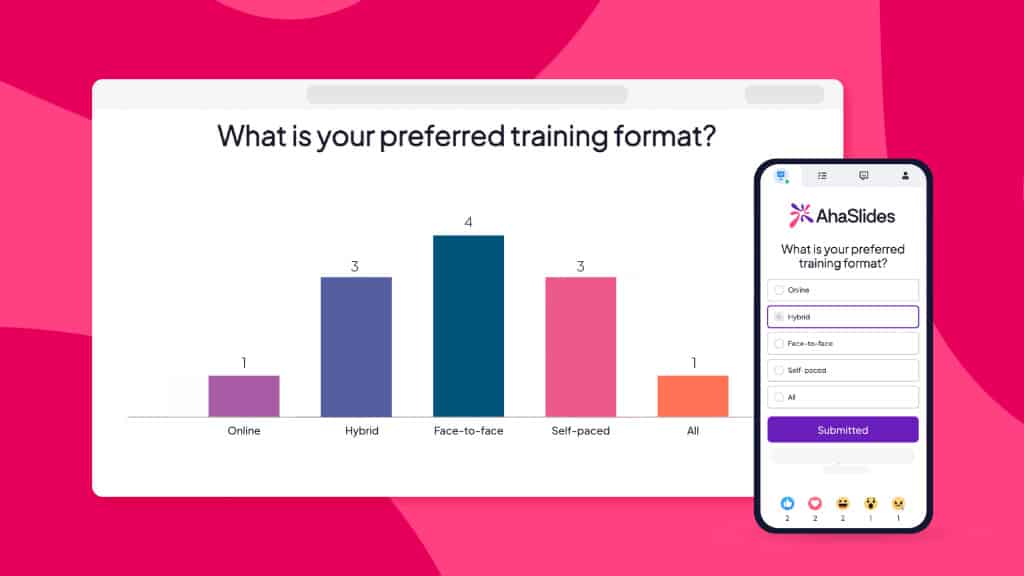
שלב 3: שלטו בתזמון בדיוק צבאי
במצגת של 5 דקות, לכל שנייה יש תפקיד. אין מרווח זמן להרהורים או להתאוששות מטעויות. דוברים מקצועיים פועלים לפי המבנה המוכח הזה:
נוסחת הקצאת הזמן המוכחת
- 0:00-0:30 – פתיחת שיר: משכו את תשומת הלב בעזרת עובדה מפתיעה, שאלה פרובוקטיבית או סיפור משכנע. דלגו על הקדמות ארוכות.
- 0:30-1:30 – הבעיה: קבע מדוע לקהל שלך צריך להיות אכפת. איזה אתגר הנושא שלך מטפל בו?
- 1:30-4:30 – הפתרון/תובנה שלך: זהו התוכן המרכזי שלך. ציין 2-3 נקודות מפתח עם ראיות תומכות. הסרת כל דבר שאינו חיוני.
- 4:30-5:00 – סיכום וקריאה לפעולה: חזקו את המסר המרכזי שלכם וספרו לקהל בדיוק מה לעשות הלאה.
התאמת מצגת וירטואלית
מציגים מרחוק? שלבו רגעי מעורבות כל 4 דקות (לפי המחקר של מדינה). השתמשו בסקרים, בקשו תגובות בצ'אט או שאלו שאלות רטוריות. בדקו את זווית הצילום (גובה העיניים), ודאו תאורה חזקה מלפנים ובדקו את איכות השמע מראש. קהל וירטואלי נוטה יותר להסחות דעת, כך שאינטראקציה אינה אופציונלית - היא חיונית.
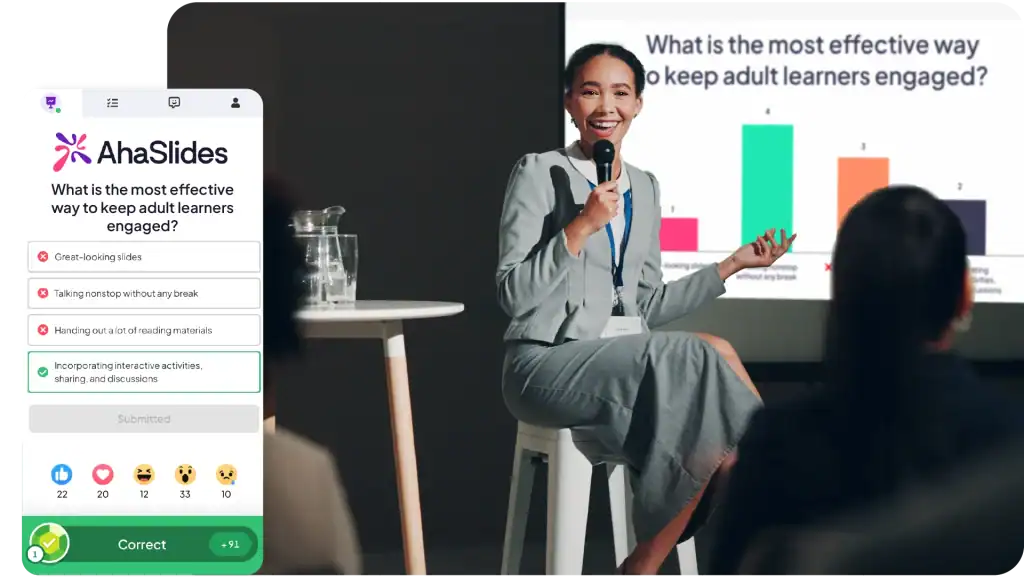
שלב 4: מסרו בביטחון אותנטי

אפילו תוכן מבריק נופל על השולחן עם הגשה גרועה. כך ניגשים אנשי מקצוע לרגע האמת:
התאמנו כאילו הקריירה שלכם תלויה בזה (כי זה אולי ככה)
תרגל את המצגת שלך בת 5 דקות לפחות 5-7 פעמים. השתמש בטיימר. הקלט את עצמך וצפה בה שוב - כואב אך יקר ערך. התאמן עד שתוכל להעביר את התוכן שלך באופן טבעי בלי לקרוא שקופיות. זיכרון שרירים יעזור לך להתמודד עם עצבנות.
טכניקות הגשה שמפרידות בין חובבנים למקצוענים
- מגוון קולי: גוון קצב, גובה צליל ועוצמה. עצירה אסטרטגית להדגשה - שתיקה היא עוצמתית.
- שפת גוף: בנוכחות פיזית, השתמשו בתנועות פתוחות ותנועו מתוך מטרה. מול המצלמה, הגבילו את המחוות (הן מגבירות) ושמרו על קשר עין עם העדשה.
- סיפורים: שלבו דוגמה או אנקדוטה קצרה ורלוונטית. סיפורים משפרים את שימור המשתמש פי 22 בהשוואה לעובדות בלבד.
- ניהול אנרגיה: התאם את האנרגיה שלך למסר שלך. נלהב להשראה, מדוד לנושאים רציניים.
- מוכנות טכנית: בדקו את הציוד 30 דקות מראש. הכינו תוכניות גיבוי לבעיות קישוריות.
סוד הקשר של הקהל
חשבו על המצגת שלכם כעל שיחה, לא כעל הופעה. שמרו על קשר עין (או הביטו למצלמה במצגות וירטואליות). הכירו בתגובות. אם אתם מועדים, עצרו לרגע והמשיכו - הקהל סלחני לאותנטיות, אבל לא לקריאת שקופיות באופן רובוטי.
טיפ סודי: לא יודעים אם המצגת שלכם בת 5 דקות משפיעה? השתמשו ב- כלי משוב לאסוף את רגשות הקהל מיד. זה דורש מאמץ מינימלי, ואתה נמנע מאבדן משוב בעל ערך לאורך הדרך.
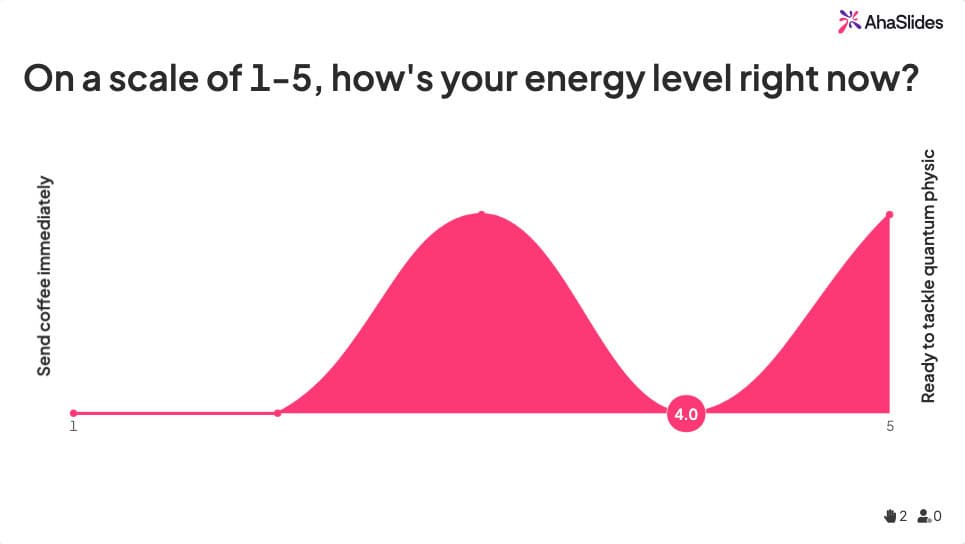
5 טעויות נפוצות בעת מתן מצגת של 5 דקות
אנו מתגברים ומסתגלים באמצעות ניסוי וטעייה, אבל קל יותר להימנע מטעויות טירונים אם אתה יודע מה הן👇
- ריצה לאורך זמן: הקהל שם לב. זה מאותת על הכנה לקויה ומזלזל בלוח הזמנים שלהם. התאמנו עד לסיום ב-4:45.
- עומס יתר של שקופיות: שקופיות עמוסות טקסט גורמות לקהל לקרוא במקום להקשיב. אתם מאבדים את תשומת ליבם באופן מיידי.
- תרגול דילוגים: "זה רק 5 דקות" זו חשיבה מסוכנת. פורמטים קצרים דורשים יותר תרגול, לא פחות.
- מנסה לכסות הכל: עומק מנצח רוחב. תובנה אחת ברורה שמהדהדת עדיפה על חמש נקודות שאף אחד לא זוכר.
- התעלמות מהקהל שלך: התאימו את התוכן לתחומי העניין, לרמת הידע ולצרכיהם. מצגות גנריות לעולם לא יצליחו.
דוגמאות למצגות של 5 דקות
למדו את הדוגמאות הבאות כדי לראות עקרונות בפעולה:
וויליאם קקוומבה: "איך רתמתי את הרוח"
זֶה TED שיחה וידאו מציג את סיפורו של ויליאם קמקוואמבה, ממציא ממלאווי, שכילד שחווה עוני, בנה טחנת רוח לשאיבת מים ולייצר חשמל לכפר שלו. הסיפור הטבעי והישר של קמקוואמבה הצליח לרתק את הקהל, והשימוש שלו בהפסקות קצרות כדי שאנשים יוכלו לצחוק הוא גם עוד טכניקה מצוינת.
סוזן ו. פיסק: "החשיבות של להיות תמציתי"
זֶה וידאו הדרכה מציע טיפים מועילים למדענים כדי לבנות את ההרצאה שלהם כך שתתאים לפורמט המצגת "5 דקות מהיר", שגם מוסבר ב-5 דקות. אם אתה מתכנן ליצור מצגת מהירה "כיצד לעשות", עיין בדוגמה זו.
ג'ונתן בל: 'איך ליצור שם מותג נהדר'
כפי שמרמז הכותרת, הדובר ג'ונתן בל ייתן לכם צעד אחר צעד מדריך כיצד ליצור שם מותג מתמשך. הוא מגיע ישר לעניין עם הנושא שלו ואז מפרק אותו למרכיבים קטנים יותר. דוגמה טובה ללמוד ממנה.
חשבונית PACE: '5 Min Pitch at Startupbootcamp'
סרטון זה מראה כיצד חשבונית PACE, סטארט-אפ המתמחה בעיבוד תשלומים מרובי מטבעות, הצליח להציג את רעיונותיו למשקיעים בצורה ברורה ותמציתית.
וויל סטיבן: "איך להישמע חכם בשיחת ה-TEDx שלך"
תוך שימוש בגישה הומוריסטית ויצירתית, הרצאת TEDx של סטיבן מנחה אנשים דרך הכישורים הכלליים של דיבור בפני קהל. צפייה חובה כדי ליצור את המצגת שלך ליצירת מופת.
מוכנים ליצור מצגות שבאמת מושכות את העין? התחל עם כלי המצגות האינטראקטיביים של AhaSlides ולהפוך את המצגת הבאה שלך בת 5 הדקות מבלתי נשכחת לבלתי נשכחת.


